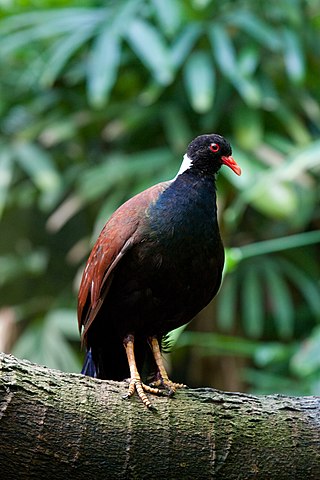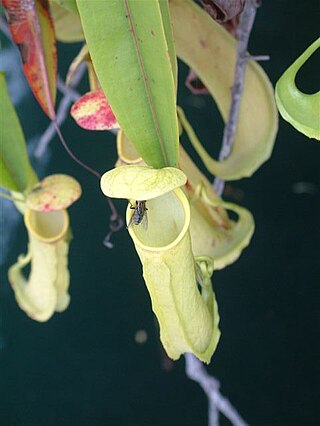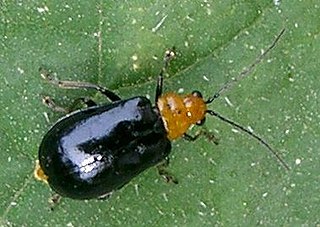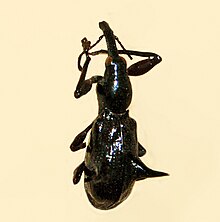
The pheasant pigeon is a species of large terrestrial pigeon. It is the only species of the monotypic genus Otidiphaps. The pheasant pigeon is found in the primary rainforests of New Guinea and nearby islands. It ranges primarily over hilly and lower mountain areas, but can also be found in lowlands.

The emerald tree monitor or green tree monitor, is a small to medium-sized arboreal monitor lizard. It is known for its unusual coloration, which consists of shades from green to turquoise, topped with dark, transversedorsal banding. This coloration helps camouflage it in its arboreal habitat. Its color also makes the emerald tree monitor highly prized in both the pet trade and zoos alike.

The rusty pitohui is a species of bird in the family Pachycephalidae. It is found throughout the lowlands of the Aru Islands and New Guinea.

Raja Ampat, or the Four Kings, is an archipelago located off of the northwest tip of Bird's Head Peninsula, Southwest Papua province, Indonesia. It comprises over 1,500 small islands, cays, and shoals around the four main islands of Misool, Salawati, Batanta, and Waigeo, and the smaller island of Kofiau.

Misool, formerly spelled Mysol or Misol, is one of the four major islands in the Raja Ampat Islands in Southwest Papua, Indonesia. Its area is 2,034 km2. The highest point is 561 m and the main towns are Waigama, located on the island's northwest coast, and Lilinta on the island's southeast coast.

The glossy swiftlet is a species of swift in the family Apodidae. It is found on the Indonesian island of Sulawesi and eastwards to New Guinea, the Bismarck Archipelago and the Solomon Islands.

The New Guinea bronzewing is a species of bird in the pigeon and dove family Columbidae. It is found in New Guinea. Its natural habitats are subtropical or tropical moist lowland forests and subtropical or tropical moist montane forests.

The frilled monarch is a species of bird in the family Monarchidae. As currently defined, its range is restricted to forest on New Guinea and nearby smaller islands, but historically it has included some or all of the remaining members of the genus Arses as subspecies.

The grey whistler or brown whistler, is a species of bird in the family Pachycephalidae. It is found in northern Australia and New Guinea. Its natural habitats are subtropical or tropical moist lowland forest and subtropical or tropical mangrove forest.

Melanotaenia is a genus of rainbowfish from Australia, Indonesia, New Guinea, and nearby smaller islands.

Paropsis is a genus of Chrysomelidae, commonly referred to as tortoise beetles, which includes over 70 described species. Their small size, bright colours and patterns, and roughly hemispherical shape cause them to be mistaken for beetles in the family Coccinellidae (ladybirds). They are distributed across Australia, New Zealand and Papua New Guinea. Some species, Paropsis atomaria in particular, have been introduced to the United States in California with first official documented sightings in 2022. They primarily feed on Eucalyptus but there are a few that feed on Baeckea, Kunzea and Leptospermum. Species within this genus are noted as pests. For example, Paropsis charybdis is a pest of Eucalyptus in New Zealand.

Aulacophora is a genus of beetles in the family Chrysomelidae, commonly known as pumpkin beetles; some species are pests of agricultural crops. The genus was named in 1836 by the French entomologist Louis Alexandre Auguste Chevrolat, in Dejean's Catalogue des Coléoptères. The name, from Ancient Greek, signifies "furrow-bearer"' from aulax, "furrow".

Cocytia is a genus of moths in the family Erebidae. It is monotypic, being represented by the single species, Cocytia durvillii, an uncommon day-flying moth found in lowland areas of the Moluccas, Aru, and New Guinea. The species has clear wings bordered with black, with an orange patch at the base of each forewing and long antennae, thicker at the outer end. Both the genus and species were first described by Jean Baptiste Boisduval in 1828.

The peach-throated monitor, also known as the Sepik monitor, is a species of monitor lizard native to New Guinea.

Nacaduba cyanea, the tailed green-banded line-blue, is a species of butterfly in the family Lycaenidae, and formerly considered a member of the genus Danis. It is found in the Indonesia, Papua New Guinea, the Solomon Islands and Australia (Queensland).

Clyzomedus is a genus of flat-faced longhorns in the beetle family Cerambycidae. There are about 10 described species in Clyzomedus.

The Raja Ampat pitohui, or Waigeo pitohui, is a species of pitohui in the family Oriolidae found on the western Papuan Islands of New Guinea. Its natural habitat is subtropical or tropical moist lowland forests. It is also one of the few known poisonous birds.
Sarax is a genus of amblypygids of the family Charinidae.

The Vogelkop–Aru lowland rain forests is a tropical moist forest ecoregion in Indonesia. The ecoregion covers the peninsular lowlands of western New Guinea, along with the Aru Islands and other nearby islands.

Aporhina is a genus of beetles belonging to the family Brentidae.



















